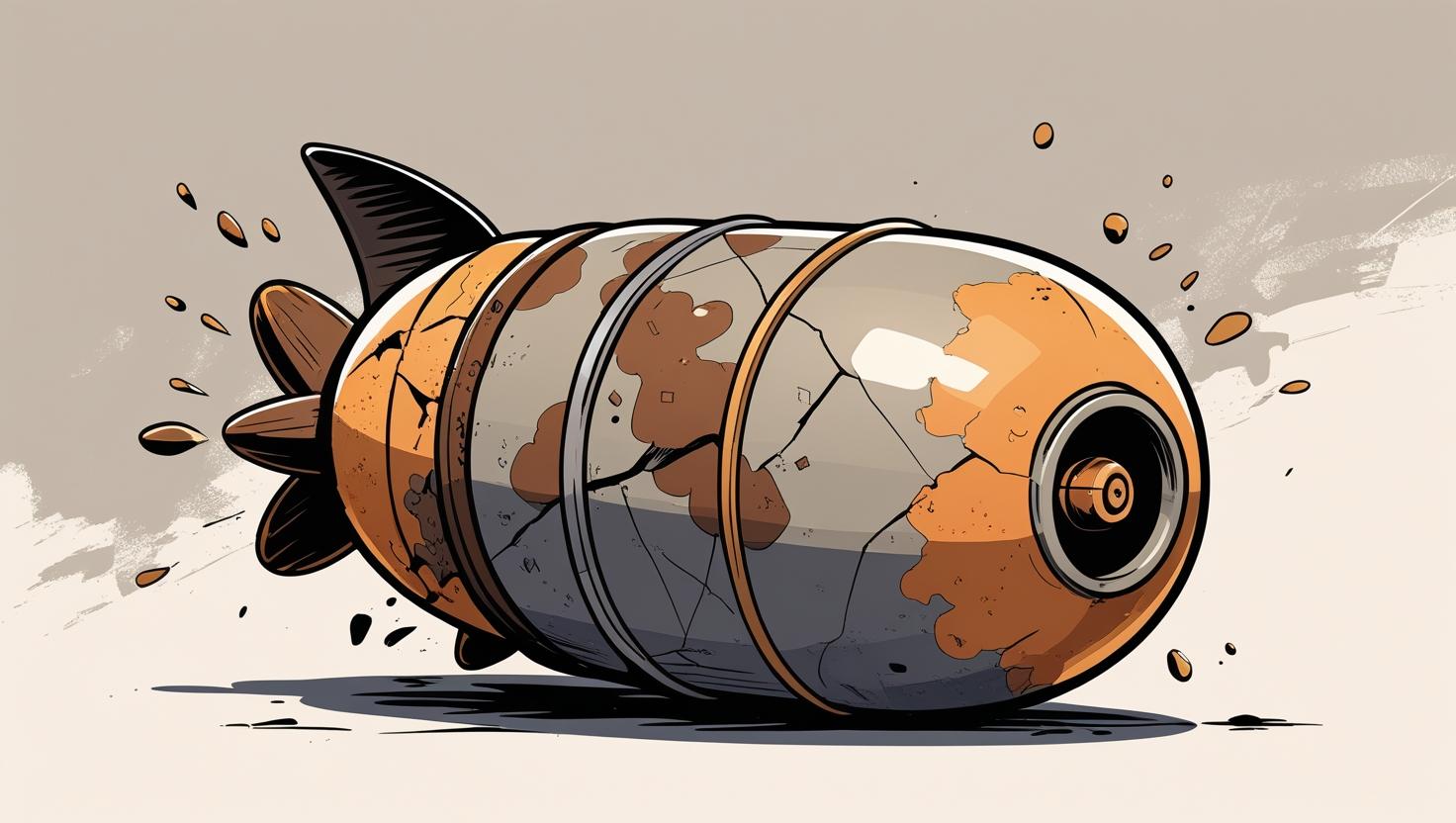As soon as EO is produced, it begins to age and degrade. Certain components, such as stabilisers in propellants, degrade relatively quickly, whereas others, like thick‑cased projectiles designed to endure extreme firing forces, can remain robust for a long time. The exact speed and nature of the ageing process depend on the construction of the munition and the specific environmental factors it encounters over time.
The differential rate of decay among components can significantly affect the EOD operator. For example, a munition may be fuzed with a cocked striker whose holding device degrades faster than the coiled spring, causing the munition to become increasingly sensitive over time. Consequently, a munition can be in a highly uncertain state depending on the extent and nature of corrosion.
This variability also influences detection and identification. Corrosion of ferrous materials generally makes them harder to locate with metal detectors, and a corroded appearance can complicate visual identification.
As a rule of thumb, munitions designed to experience substantial forces (with thicker casings) tend to be more resilient. Fragmentation munitions are usually more robust than thin‑skinned blast munitions. Nevertheless, thin‑skinned plastic munitions, when protected from UV exposure and harsh environments, can be remarkably durable.
Primary Explosives
Different primary explosives deteriorate in distinct ways. Mercury fulminate decomposes into relatively stable compounds, producing a munition that is less likely to function. Tetracene, on the other hand, breaks down in the presence of moisture and temperatures > 60 °C, forming more sensitive compounds such as 5‑azidotetrazole.
A common primary explosive—lead azide—produces a decay product (hydrogen azide gas, HN₃) that can react with metals like copper, zinc, cadmium, or their alloys to form highly sensitive explosive compounds. This is why lead‑azide detonators are pressed into an aluminium liner when encased in such metals. While some moisture ingress generates hydrogen azide, excessive saturation can actually reduce functionality. Mines discovered in the Falkland Islands are suspected to have suffered from this defect.
Secondary Explosives
The main fills and boosters found in ordnance dating back to World I have proven to be very stable. TNT and Comp B recovered from the world wars remain in good condition with minimal deterioration, typically having no significant impact on performance. An exception is picric acid (2,4,6‑trinitrophenol, TNP), which was used as a booster and HE fill but reacts with certain metals to form sensitive picrate salts.
Propellants
Compounds such as nitrocellulose (NC) and nitroglycerine (NG) often combined to produce double‑based propellants are initially reasonably stable but decompose over years, especially when exposed to high temperatures. Specific bonds (the O‑NO₂ bond of aliphatic nitrate esters) break down to yield nitrogen dioxide and an alkoxyl radical. Stabilisers are added to these NG/NC formulations, but they typically retain effectiveness for only about 20 years. Over time, propellants become dry and brittle, increasing their susceptibility to ignition from heat or friction. Propellants are generally far more sensitive to ignition than high explosives and are a frequent cause of ammunition‑depot fires.
In sealed containers (e.g., most rocket motors), the nitrogen dioxide gas remains trapped, raising internal pressure and accelerating propellant breakdown. This can eventually lead to spontaneous ignition or explosion via autocatalytic initiation—a mechanism linked to several major stockpile explosions.
Materials
Material selection for munition manufacture balances performance, intended service life, and cost. When exposed to the elements for extended periods rather than stored in a controlled environment, temperature cycling and the generation of decomposition gases can cause pressure changes that crack certain casings, especially plastic ones.
The most important factor governing casing longevity is thickness, because most degradation is a surface phenomenon. Material type also matters:
- Aluminium and stainless steel develop protective oxide films.
- Iron oxide is porous and offers little protection.
- Copper‑based alloys (bronze, brass) exhibit varying corrosion resistance. Bronze (copper‑tin) performs well in seawater and can be further improved with silicon; brass (copper‑zinc) benefits from tin additions but degrades with higher zinc content.
Even when rust is encapsulated by another material (e.g., clay), it may retain some protective qualities, so thickness remains crucial and corrosion rates drop if the outer oxide layer stays intact.
Plastics resist the kinds of corrosion that affect metals, yet they can degrade through UV exposure and heat. Consequently, thickness still matters for protecting the interior. Wood is the least resilient to weathering; even treated wood tends to rot within a few years, affecting wooden mines such as the Russian PMD‑6 or bounding mines with wooden stakes. Nonetheless, if a munition becomes encased in a protective medium, it can persist remarkably long.
Design and Production
Design profoundly influences munition longevity, sometimes intentionally. Small gravel mines used by the U.S. in Indochina were encased in cloth and designed to function for only a few days; self‑neutralisation via moisture ingress was a built‑in feature. Conversely, thick fibreglass casings can remain robust for decades.
Beyond overall case material, welds, seals, and assembly quality also affect weathering resistance. Poor workmanship can dramatically reduce a munition’s durability.
Damage on Employment and Differential Weathering
Identical munitions placed a short distance apart can age very differently depending on how they land or are positioned. A munition that lands in a sheltered spot, above the waterline, and sustains no damage can survive far longer than one that breaks, abrades, or experiences harsher micro‑climatic conditions.
The original publication this is based on is from the Geneva International Centre for Humanitarian Demining (GICHD) and can be found at gichd.org under Publications.


Leave a Reply